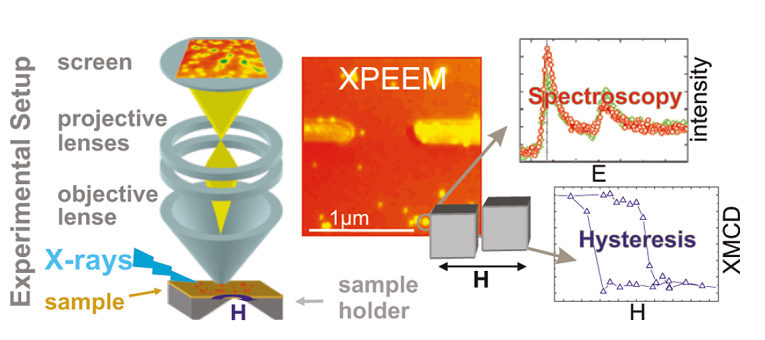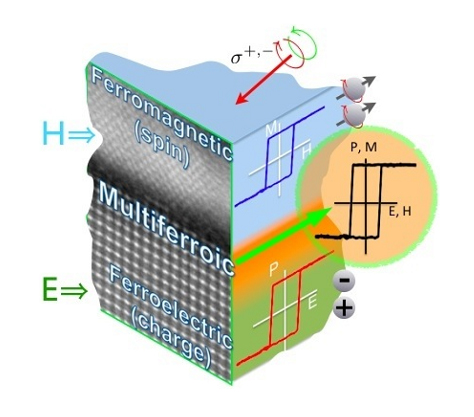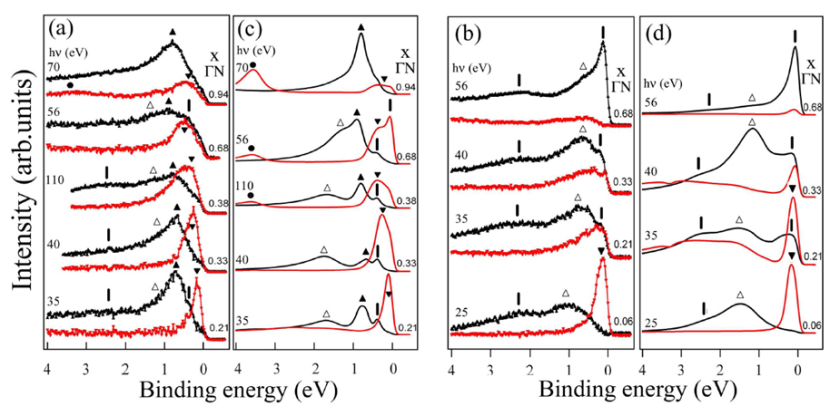Department Spin and Topology in Quantum Materials
Controlling spin-dependent phenomena
Materials for Green Spintronics: Controlling Spin-based Phenomena
Switching ferromagnetism on and off close to room temperature by a small Voltage
Being able to control magnetism in materials by means of small voltages would represent a step forward in order to be able to design low-power spintronics applications in the future. Although much effort has been put in this direction the possibility of switching robust ferromagnetism on and off by applying small voltages has remain elusive, until now. In collaboration with the group of Dr. Manuel Bibes and Prof. Dr. Agnes Barthelemy from CNRS/Thales we have recently shown the possibility of switching the magnetic ordering of thin FeRh films between ferromagnetic and antiferromagnecs by applying small magnetic fields.
More information within the HZB higlights or directly from our publications in Nature Materials and Scientific Reports
Related publications:
Electric-field control of magnetic order above room temperature
R. O. Cherifi, V. Ivanovskaya, L. C. Phillips, A. Zobelli, I. C. Infante, E. Jacquet, V. Garcia, S. Fusil, P. R. Briddon, N. Guiblin, A. Mougin, A. A. Ünal, F. Kronast, S. Valencia, B. Dkhil, A. Barthélémy & M. Bibes
Nature Materials 13, 345 (2014) doi:10.1038/nmat3870
L. C. Phillips, R. O. Cherifi, V. Ivanovskaya, A. Zobelli, I. C. Infante, E. Jacquet, N. Guiblin, A. A. Ünal, F. Kronast, B. Dkhil, A. Barthélémy, M. Bibes & S. Valencia
Scientific Reports 5, Article number: 10026 (2015) doi:10.1038/srep10026
Graphene for spintronics
This activity began with the observation of quasifreestanding graphene on nickel(111) after intercalation of gold which also caused a measurable spin-orbit splitting in the graphene π-band of ~13 meV (Varykhalov 2008). Meanwhile, sample growth has been improved considerably so that giant spin-orbit splittings (Rashba splittings) of ~100 meV are obtained. The figures to the left show the intact Dirac cone of the π-band signalling quasifreestanding graphene. The figures to the right show the spin-resolved spectra (spin channels in blue and red), taken at the cross marks in the Dirac cone. The reason for the giant spin-orbit effect is found in a surprisingly strong hybridization of the graphene π-band with d-states of the gold (Marchenko 2012).
Related publications:
Electronic and Magnetic Properties of Quasifreestanding Graphene on Ni
A. Varykhalov, J. Sánchez-Barriga, A. M. Shikin, C. Biswas, E. Vescovo, A. Rybkin, D. Marchenko & O. Rader
Phys. Rev. Lett. 101, 157601 (2008)
Is There a Rashba Effect in Graphene on 3d Ferromagnets?
O. Rader, A. Varykhalov, J. S anchez-Barriga, D. Marchenko, A. Rybkin & A. M. Shikin
Phys. Rev. Lett. 102, 057602 (2009)
Magnetic Nanostructures
Magnetic nanostructures and interfaces are at the heart of information technologies and spintronics. Typical dimensions of magnetic bits are in the sub-100nm region. In addition novel magnetoelectronics devices such as magnetic random access memory junctions are operated on the sub-µm length scale. Typical magnetic switching times are approaching the sub-100 ps timescale. An understanding of static and dynamic magnetic properties of such low-dimensional structures is only accessible to spectro-microscopy tools capable of appropriate lateral and temporal resolution. Using x-ray photoemission microscopy we investigate electronic structure and magnetic responses of single ferromagnetic nanoparticles. The figure shows spectra and magnetic responses of chemically synthesized Fe nanocubes with 18nm edgelength. Magnetic states and interactions of monomers, dimers, and trimers can be analyzed for different particle arrangements. Comparing experimental data to micromagnetic simulations we reveal the influence of dipolar coupling and intrinsic magnetic anisotropy on the magnetic properties of individual nanomagnets and their configurations.
Related Publication:
Element-Specific Magnetic Hysteresis of Individual 18 nm Fe Nanocubes
F. Kronast, N. Friedenberger, K. Ollefs, S. Gliga, L. Tati-Bismaths, R. Thies, A. Ney, R. Weber, C. Hassel, F.M. Römer, A.V. Trunova, C. Wirtz, R. Hertel, H.A. Dürr & M. Farle
Nano Letters 11, 1710 (2011)
Multiferroic materials and their functionalization
Multiferroics compounds (showing coexistance of ferromagnetic and ferroelectric ordering) have not been exploited in devices owing to the scarcity of room-temperature examples. Those that are ferromagnetic and ferroelectric have potential applications in multi-state data storage if the ferroic orders switch independently, or in electric-field controlled spintronics if the magnetoelectric coupling is strong. Future applications could also exploit toroidal moments and optical effects that arise from the simultaneous breaking of time-reversal and space-inversion symmetries. Our previous results demonstrate the possibility to induce room temperature multiferrocity at the interface of BaTiO3 (an archetypal ferroelectric) when in contact with Fe or Co. Future research is focused on voltage control of magnetic properties.
Related publications:
Interface-induced room-temperature multiferroicity in BaTiO3
S. Valencia, A. Crassous, L- Bocher, V. Garcia, X. Moya, R.O. Cherifi, C. Deranlot, K. Bouzehouane, S. Fusil, A. Zobelli, A. Gloter, N.D. Mathur, A. Gaupp, R. Abrudan, F. Radu, A. Barthélémy & M. Bibes
Nature Materials 10, 753 (2011)
Ferroelectric Control of Spin Polarization
V. Garcia, M. Bibes, L. Bocher, S. Valencia, F. Kronast, A. Crassous, X. Moya, S. Enouz-Vedrenne, A. Gloter, D. Imhoff, C. Deranlot, N. Mathur, S. Fusil, K. Bouzehouane & A. Barthélémy
Science 327, 1106 (2010)
Correlation effects in the spin-dependent electronic structure of Fe, Co and Ni
This research activity aims at comparing the spin-dependent electronic structure of ferromagnets to their description by modern theoretical models developed mainly for strongly correlated systems, and it is the question whether these models resolve the well-known discrepancies between experiment and local-spin-density calculations. This comparison takes into account matrix elements as well as surface states via a 1-step treatment of the photoemission process. The comparison has been done for Fe (see figure), Co, Ni, and permalloy and the central result is that the theoretical description is still insufficient.
The figure shows spin-dependent electron correlation in Fe measured from the Fe(110) surface in normal emission at various photon energies (x gives the corresponding perpendicular wave vector k in units of the N distance). (a,b) Experimental data and (c,d) dynamical mean-field theory with 1-step photoemission calculation. (a,c) p- and (b,d) s-polarized light. Even these state-of-the-art treatments of electron correlation do not give a satisfactory description of real and imaginary parts of the self energy.
Related publications:
Strength of Correlation Effects in the Electronic Structure of Iron
J. Sánchez-Barriga, J. Fink, V. Boni, I. Di Marco, J. Braun, J. Minár, A. Varykhalov, O. Rader, V. Bellini, F. Manghi, H. Ebert, M.I. Katsnelson, A.I. Lichtenstein, O. Eriksson, W. Eberhardt & H.A. Dürr
Phys. Rev. Lett. 103, 267203 (2009)
J. Sánchez-Barriga, J. Minár, J. Braun, A. Varykhalov, V. Boni, I. Di Marco, O. Rader, V. Bellini, F. Manghi, H. Ebert, M. I. Katsnelson, A. I. Lichtenstein, O. Eriksson, W. Eberhardt, H. A. Dürr & J. Fink
Phys. Rev. B 82, 104414 (2010)
J. Sánchez-Barriga, J. Braun, J. Minár, I. Di Marco, A. Varykhalov, O. Rader, V. Boni, V. Bellini, F. Manghi, H. Ebert, M. I. Katsnelson, A. I. Lichtenstein, O. Eriksson, W. Eberhardt, H. A. Dürr & J. Fink
Phys. Rev. B 85, 205109 (2012)
Strong Spin Dependence of Correlation Effects in Ni due to Stoner Excitations
J. Sánchez-Barriga, R. Ovsyannikov & J. Fink
Phys. Rev. Lett 121, 267201 (2018)
Topological insulators
Based on the experimental and theoretical literature, it has been believed that magnetic impurities at the surface of topological insulators open a band gap in the topologically protected surface state due to the breaking of time-reversal symmetry. We have demonstrated that, instead, the topological surface states are robust against magnetic impurities which enables functional interfaces with ferromagnets to be built.This holds for the single impurities created at 10 K deposition as well as clustering and possibly intermixing phases at room temperature.
Related Publication:
Tolerance of Topological Surface States towards Magnetic Moments: Fe on Bi2Se3
M. R. Scholz, J. Sánchez-Barriga, D. Marchenko, A. Varykhalov, A. Volykhov, L. V. Yashina & O. Rader
Phys. Rev. Lett. 108, 256810 (2012)





